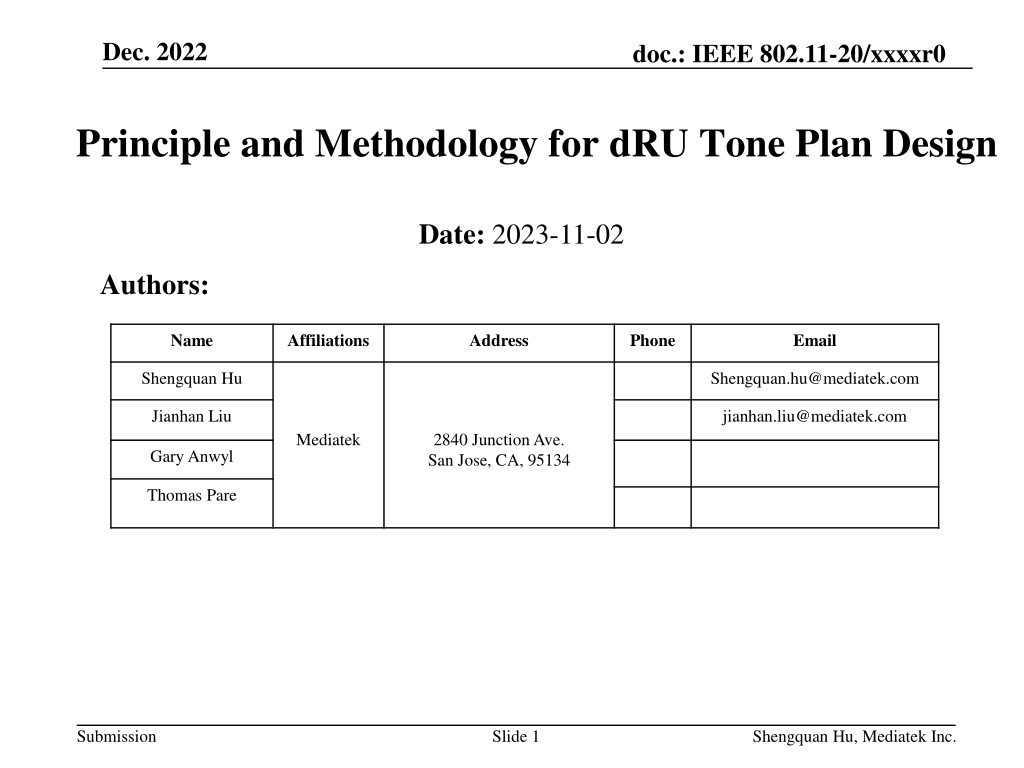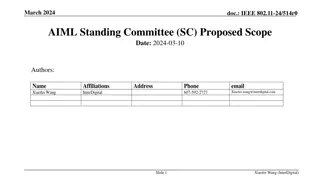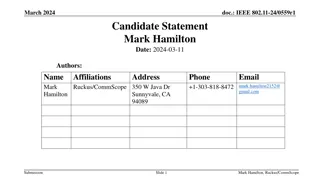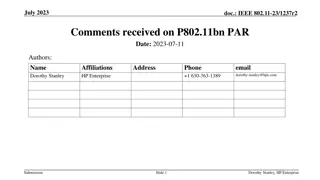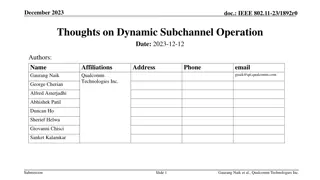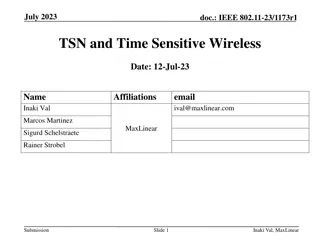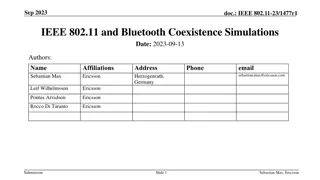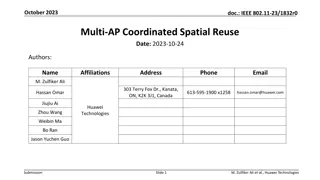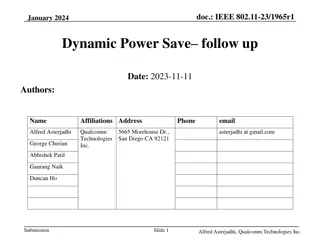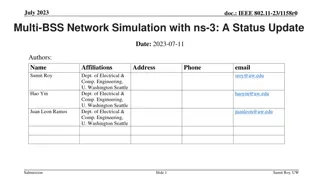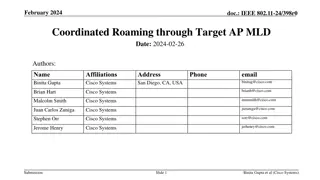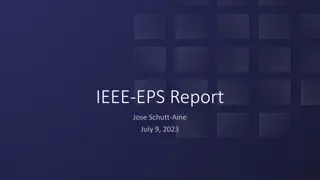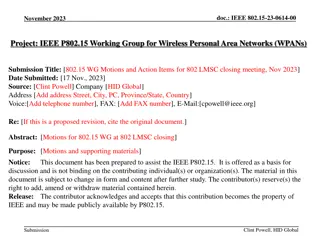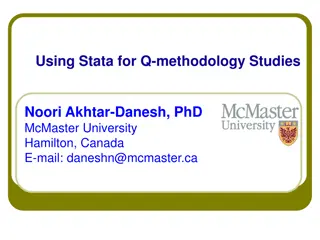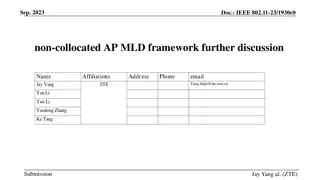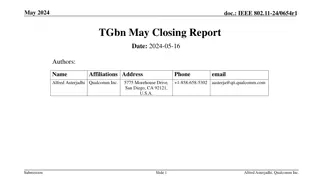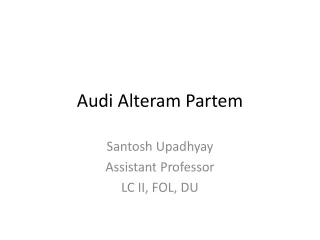Principle and Methodology for dRU Tone Plan Design in IEEE 802.11-20
Introduction of Distributed Tone RU (dRU) as a potential UHR PHY feature to address PSD limitations for 6GHz LPI and enhance Rate vs. Range performance. Emphasis on dRU tone plan design criteria, methodologies, and performance simulations. Detailed examination of design principles, methods, considerations, and comparison of different dRU design approaches, favoring the 26-tone RU based method as optimal.
Download Presentation
Please find below an Image/Link to download the presentation.
The content on the website is provided AS IS for your information and personal use only. It may not be sold, licensed, or shared on other websites without obtaining consent from the author. Download presentation by click this link. If you encounter any issues during the download, it is possible that the publisher has removed the file from their server.
Presentation Transcript
Dec. 2022 doc.: IEEE 802.11-20/xxxxr0 Principle and Methodology for dRU Tone Plan Design Date: 2023-11-02 Authors: Name Affiliations Address Phone Email Shengquan Hu Shengquan.hu@mediatek.com Jianhan Liu jianhan.liu@mediatek.com Mediatek 2840 Junction Ave. San Jose, CA, 95134 Gary Anwyl Thomas Pare Submission Slide 1 Shengquan Hu, Mediatek Inc.
Dec. 2022 doc.: IEEE 802.11-20/xxxxr0 Introduction Distributed tone RU (dRU) has been discussed and proposed as one of the potential UHR PHY features to overcome the strict PSD limitation issues for 6GHz LPI and improve Rate vs Range (RvR) performance We have shared the high-level views on the dRU in [1] in term of distribution BW, optimal distribution gains, dRU sizes and different dRU operation modes dRU tone plan is the fundamental for dRU design in 11bn. In this contribution, we will share our thoughts on the general design principles and methodologies for dRU tone plan such as dRU design criteria and target different dRU design approaches Pros & cons analysis and comparisons Example illustrations of dRU tone plan Preliminary performance simulations such as dRU with channel smoothing, CFO impact & ICI cancellations on dRU, etc Our studies show that 26-tone RU based dRU design method is the best choice to meet all of the design criteria and targets Submission Slide 2 Shengquan Hu, Mediatek Inc.
doc.: IEEE 802.11-20/xxxxr0 Design principles & methodologies of dRU Tone Plan Minimize the number of tones per 1MHz to achieve the optimal power boost gain. Preserve dRU hierarchical structure as regular RU (rRU) to allow simple signaling of dRUs The key for simplified signaling of dRU is to have a one-to-one mapping between the rRU and the dRU Can reuse the existing RU Allocation table Allow scheduling and distributing different size dRUs without overlapped tones. Do not introduce new RU sizes to avoid extra different data rates and extra parsing, interleaving and encoding. Achieve uniform or near-uniform tone distribution pattern for simpler smoothing algorithms, easier phase tracking, ICI cancellation and improved diversity Reserve enough edge tones (e.g. left-12 & right-11 tone for dRU on BW40/80, left-6 & right- 5 for BW20) Reserve enough DC tones (e.g. >= 5 DC tone for dRU on BW40/80, >=3dB for BW20) Tones distributed over non-OFDMA tone plan range dRU subcarrier indices generation with PAPR reduction Submission Slide 3 Shengquan Hu, Mediatek Inc.
doc.: IEEE 802.11-20/xxxxr0 Considerations of dRU Tone Plan Design Several approaches/design options have been studied for tone distribution over 20/40/80MHz such as o Global Dtm method o Tone Group Based method o Perfect Uniformly Distribution method o 26-tone RU Based method Method Pros Cons Global Dtm method Wrap around issue to cause un-evenly data & pilot tone distributions Challenging to perform cannel smoothing Each dRU has different distribution pattern varying PAPR Achieve optimal power boost gain Equation based dRU distribution Tone Group Based method Near-evenly distributed in grouped tone fashion Design friendly for channel smoothing Suboptimal power boost gain. Up to 1.25dB gain loss for 4 cases (dRU52/106 on BW20, dRU106/242 on BW40) Only support 8 dRU26 on BW20, 16 dRU26 on BW40 Repeating with period of 16 tones will cause PD false detection issues Perfect Uniformly Distribution method Perfect evenly tone distributions for all dRUs on BW20/40/80 Design friendly for channel smoothing Same as above 26-tone RU based method meets all the design criteria, achieve optimal power boost gains for all size dRU, preserve hierarchical structure, uniformly/near-uniformly distributed tone patterns make channel smoothing much easier We will focus on 26-tone RU based method in this contribution, the other methods can be found in the appendix Submission Slide 4 Shengquan Hu, Mediatek Inc.
doc.: IEEE 802.11-20/xxxxr0 26-tone RU Based dRU Design Method rRU has the hierarchical structure, i.e. each each larger size RU consists of corresponding smaller size RU tones For an example, one rRU52 consists of tones from two rRU26s, one rRU106 consists of tones from two rRU52 or four rRU26 with two extra tones This hierarchical structure makes RU assignment & scheduling much simpler It would be desired for dRU to maintain the similar hierarchical structure to make dRU implementation more friendly, scheduling easier and signaling simpler dRU will maintain the similar hierarchical structure as rRU Submission Slide 5 Shengquan Hu, Mediatek Inc.
doc.: IEEE 802.11-20/xxxxr0 26-tone RU Based dRU Design Method Using dRU26 as a basic building block, all other sized dRUs are built on dRU26 tone plan - dRU52 is built from two dRU26 - dRU106 is built from four dRU26 or two dRU52 with 2 extra padding tones - dRU242 is built from nine dRU26 with 8 extra padding tones, or two dRU106 & one dRU26 with 4 padding tones - dRU484 is built from two dRU242 Not change the number of RUs for each BW, keep the same ordering of RUs Reuse the existing RU allocation table The detailed indices will be discussed & filled up later Example of 26-tone RU Based dRU Tone Plan Structure for BW20 Data and pilot subcarrier indices for distributed tone RUs (dRU) in a 20 MHz UHR TB PPDU for 6GHz LPI dRU type dRU index and subcarrier range dRU1 dRU2 dRU3 dRU4 dRU5 26-tone dRU i=1:9 dRU6 dRU7 dRU8 dRU9 dRU1 dRU2 26-tone [dRU1, dRU2] 26-tone [dRU3, dRU4] 52-tone dRU i=1:4 dRU3 dRU4 26-tone [dRU6, dRU7] 26-tone [dRU8, dRU9] 106-tone dRU i=1:2 dRU1 dRU2 26-tone [dRU1~4], 2 padding tones 26-tone [dRU6~9], 2 padding tones Submission Slide 6 Shengquan Hu, Mediatek Inc.
doc.: IEEE 802.11-20/xxxxr0 26-tone RU Based dRU Tone Plan Structure for BW40 The detailed indices will be discussed & filled up later Data and pilot subcarrier indices for distributed tone RUs (dRU) in a 40 MHz UHR TB PPDU for 6GHz LPI dRU index and subcarrier range dRU type dRU1 dRU2 dRU3 dRU4 dRU5 dRU6 26-tone dRU i=1:18 dRU7 dRU8 dRU9 dRU10 dRU11 dRU12 dRU13 dRU14 dRU15 dRU16 dRU17 dRU18 dRU1 dRU2 dRU3 26-tone [dRU1, dRU2] 26-tone [dRU3, dRU4] 26-tone [dRU6, dRU7] dRU4 dRU5 dRU6 52-tone dRU i=1:8 26-tone [dRU8, dRU9] 26-tone [dRU10, dRU11] 26-tone [dRU12, dRU13] dRU7 dRU8 26-tone [dRU15, dRU16] 26-tone [dRU17, dRU18] dRU1 dRU2 dRU3 26-tone [dRU1~4], 2 extra tones 26-tone [dRU6~9], 2 extra tones 26-tone [dRU10~13], 2 extra tones 106-tone dRU i=1:4 dRU4 26-tone [dRU15~18], 2 extra tones dRU1 dRU2 242-tone dRU i=1:2 106-tone [dRU1~2],26-tone dRU5, 4 extra tones 106-tone [dRU3~4],26-tone dRU14, 4 extra tones Submission Slide 7 Shengquan Hu, Mediatek Inc.
doc.: IEEE 802.11-20/xxxxr0 26-tone RU Based dRU Tone Plan Structure for BW80 The detailed indices will be discussed & filled up later Data and pilot subcarrier indices for distributed tone RUs (dRU) in a 80 MHz UHR TB PPDU for 6GHz LPI dRU1 dRU2 dRU3 dRU4 26-tone [dRU1, dRU2] 26-tone [dRU3, dRU4] 26-tone [dRU6, dRU7] 26-tone [dRU8, dRU9] dRU5 dRU6 dRU7 dRU8 26-tone [dRU10, dRU11] 26-tone [dRU12, dRU13] 26-tone [dRU15, dRU16] 26-tone [dRU17, dRU18] 52-tone dRU i=1:16 dRU9 dRU10 dRU11 dRU12 26-tone [dRU20, dRU21] 26-tone [dRU22, dRU23] 26-tone [dRU25, dRU26] 26-tone [dRU27, dRU28] dRU13 dRU14 dRU15 dRU16 26-tone [dRU29, dRU30] 26-tone [dRU31, dRU32] 26-tone [dRU34, dRU35] 26-tone [dRU36, dRU37] dRU1 dRU2 dRU3 dRU4 52-tone [dRU1~2], 2 extra tones 52-tone [dRU3~4], 2 extra tones 52-tone [dRU5~6], 2 extra tones 52-tone [dRU7~8], 2 extra tones 106-tone dRU i=1:8 dRU5 dRU6 dRU7 dRU8 52-tone [dRU9~10], 2 extra tones 52-tone [dRU11~12], 2 extra tones 52-tone [dRU13~14], 2 extra tones 52-tone [dRU15~16], 2 extra tones dRU1 dRU2 242-tone dRU i=1:4 106-tone [dRU1~2],26-tone dRU5, 4 extra tones dRU3 106-tone [dRU5~6],26-tone dRU24, 4 extra tones 106-tone [dRU3~4],26-tone dRU14, 4 extra tones dRU4 106-tone [dRU7~8],26-tone dRU33, 4 extra tones 484-tone dRU i=1:2 dRU1 dRU2 242-tone [dRU1~2] 242-tone [dRU3~4] NOTE: same as rRU, the 19thdRU26 is left as Not defined Submission Slide 8 Shengquan Hu, Mediatek Inc.
doc.: IEEE 802.11-20/xxxxr0 26-tone RU Based dRU Design Method The key for design 26-tone RU based dRU design method is to generate 26-tone dRU To achieve the optimal gains and better distribution patterns, the following tone separation distance/or repetition period for dRU26 on different distribution BW can be considered: - Np = 9 for BW20 - Np = 18 for BW40 - Np = 36 for BW80 Np=9 dRU26 distribution pattern on BW20 Np=18 dRU26 distribution pattern on BW40 Submission Slide 9 Shengquan Hu, Mediatek Inc.
doc.: IEEE 802.11-20/xxxxr0 Example Illustration of dRU Distribution Pattern: dRU on BW40 26-tone dRUs are perfect uniformly distributed over 40MHz 52-tone dRUs are perfect uniformly distributed over 40MHz Submission Slide 10 Shengquan Hu, Mediatek Inc.
doc.: IEEE 802.11-20/xxxxr0 Example Illustration of dRU Distribution Pattern: dRU on BW40 106-tone dRUs are near-uniformly distributed over 40MHz Submission Slide 11 Shengquan Hu, Mediatek Inc.
doc.: IEEE 802.11-20/xxxxr0 dRU With vs Without Channel Smoothing dRU with evenly or near-evenly distributed patterns make channel smoothing & optimization much easier Our studies show that channel smoothing can provide more than 2dB smoothing gain beyond the power boost gain The following table shows the performance comparison of channel estimation with vs without smoothing: - dRU26 and dRU52 on BW40 - D-NLOS, 1T2R, MCS1 - LSCE: Least-Squared Channel Estimation without channel smoothing - SMCE: Channel estimation with smoothing Logical RU26 index 1 2 3 4 5 6 7 8 9 10 11 12 Delta (dB) (LSCE-SMCE) 1.33 1.39 1.28 1.3 0 1.31 1.18 1.24 1.24 1.29 1.35 1.4 LSCE SMCE Logical RU52 index 1 2 3 4 5 6 7 8 Delta (dB) (LSCE-SMCE) 2.13 2.16 2.13 2.17 2.13 2.17 2.25 2.14 LSCE SMCE 6.85 6.95 6.89 6.94 5.52 5.56 5.61 5.64 6.59 6.59 6.68 6.67 6.59 6.66 6.73 6.62 4.46 4.43 4.55 4.50 4.46 4.49 4.48 4.48 6.93 6.87 6.82 6.86 6.81 6.84 6.94 5.62 5.69 5.58 5.62 5.52 5.49 5.54 Average (dB) 2.16 average(dB) 1.3 Submission Slide 12 Shengquan Hu, Mediatek Inc.
doc.: IEEE 802.11-20/xxxxr0 Impact of CFO on dRU Impact of CFO becomes concerns for dRU due to the ICI introduced from neighbor users tones Our studies show that - Less impact for low to medium MCS (e.g. MCS0~7) even for up to 1KHz CFO (assume after pre-correction for UL TB OFDMA) - Higher MCS (>=9) become more sensitive to CFO>500Hz - Simple ICI cancellation can improve the performance for higher MCS (e.g. >= MCS9) - Better dRU tone distribution pattern makes ICI canceller implementation simpler The following table shows sensitivity requirements of MCS-4/7/9/11 @10% PER when UL TB OFDMA transmission using dRU with different CFO - 4 UL TB users, each with dRU242 on BW80 - D-NLOS, LDPC, channel estimation with smoothing - 1T2R, assume ideal FOE for ICI No ICI Cancellation - Required SNR (dB) FOE Error (Hz) 350 500 1k 3k 9.5 9.5 9.6 10.0 16.9 16.9 17.2 20.5 22.6 22.7 23.4 Inf 28.6 29.0 38.9 Inf Delta vs 0 Hz 500 0.1 0.0 0.4 0.8 MCS 4 7 9 11 0 175 9.5 16.9 22.4 28.2 175 0.0 0.0 0.1 0.0 350 0.1 0.0 0.2 0.5 1k 0.1 0.3 1.1 10.8 3k 0.5 3.6 9.5 16.9 22.3 28.1 #VALUE! #VALUE! With simple ICI Cancellation - Required SNR (dB) FOE Error (Hz) 350 500 1k 3k 9.6 9.5 9.5 9.8 16.9 16.9 17.1 18.3 22.7 22.7 23.1 Inf 28.4 28.8 31.0 Inf Delta vs 0 Hz 500 0.1 0.0 0.4 0.6 MCS 4 7 9 11 0 175 9.5 16.9 22.6 28.2 175 0.1 0.0 0.3 0.0 350 0.1 0.1 0.4 0.3 1k 0.1 0.2 0.8 2.9 3k 0.3 1.4 9.5 16.9 22.3 28.1 #VALUE! #VALUE! Submission Slide 13 Shengquan Hu, Mediatek Inc.
Dec. 2022 doc.: IEEE 802.11-20/xxxxr0 Summary We share our thoughts on dRU tone plan design which includes dRU design criteria, methodology and design target Several different approaches for dRU tone plan design Our studies show that 26-tone RU based dRU tone plan would be the best choice Meets all the design target and achieve optimal power boost gain Preserve hierarchical structure as rRU Better tone distribution pattern with either uniformly or near-uniformly distributed Easier for channel smoothing and simpler for scheduling/signaling Submission Slide 14 Shengquan Hu, Mediatek Inc.
doc.: IEEE 802.11-20/xxxxr0 Straw Poll #1 Do you support that dRUs tone plan design scheme for 11bn is 26-tone RU based dRU method (using 26-tone dRUs as basic building blocks)? Submission Slide 15 Shengquan Hu, Mediatek Inc.
doc.: IEEE 802.11-20/xxxxr0 Reference [1]. 11-23-2020-00-00bn-high-level-perspective-on-distributed-tone- ru-for-11bn Submission Slide 16 Shengquan Hu, Mediatek Inc.
doc.: IEEE 802.11-20/xxxxr0 Appendix Submission Slide 17 Shengquan Hu, Mediatek Inc.
doc.: IEEE 802.11-20/xxxxr0 Option-1: Global Dtm Method Global Dtm like tone mapping over entire distribution BW Simple equation based dRU tone generation Parameter Dtd depends on dRU size Resulted Distributed RU tones DTM DTD Local Tone Mapper on Small- size RUs Large-Size Distributed Tone Distributor can be by-passed 52-tone RU RU 2 RU 1 26-tone RU ???= 242,484,996 ??? ???????????? ??20???,40???,80??? Submission Slide 18 Shengquan Hu, Mediatek Inc.
doc.: IEEE 802.11-20/xxxxr0 Option-1: Global Dtm Method Pros: - - Cons: - - - Achieve optimal power boost gain Simple equation based dRU distribution Wrap around issue to cause un-evenly data & pilot tone distributions Challenging to perform cannel smoothing Each dRU has different distribution pattern varying PAPR rRU52 dRU52 Submission Slide 19 Shengquan Hu, Mediatek Inc.
doc.: IEEE 802.11-20/xxxxr0 Option-2: Tone-Group Based Method Grouped-tones as one virtual tone distributed over entire BW Equation based dRU distribution with parameters of Dtd and Nsg (# of tones in a group) Grouped-tone Global Dtd DTM Distribution BW20 Large-Size Distributed Tone Distributor Local Tone Mapper on Small- size RUs 52-tone RU RU 2 RU 1 26-tone RU Nsg Dtd RU242 RU484 RU996 RU242 RU484 RU996 RU26 1 1 1 8 16 16 RU52 2 2 1 RU106 4 4 2 RU242 na 8 4 Submission Slide 20 Shengquan Hu, Mediatek Inc.
doc.: IEEE 802.11-20/xxxxr0 Option-2: Tone-Group Based Method Pros: - - Near-evenly distributed in grouped tone fashion Design friendly for channel smoothing Cons: - - - Suboptimal power boost gain. Up to 1.25dB gain loss for 4 cases (dRU52/106 on BW20, dRU106/242 on BW40) Only support 8 dRU26 on BW20, 16 dRU26 on BW40 Repeating with period of 16 tones will cause PD false detection issues 26-tone 1 2 3 4 5 6 7 8 9 10 11 12 13 14 15 16 52-tone 1 2 3 4 5 6 7 8 106-tone 1 2 3 4 242-tone 1 2 4-tones grouped for dRU106 on BW20 Nsg=4 dRU over BW20 Dtd=16 dRU over BW40 dRU over BW80 Submission Slide 21 Shengquan Hu, Mediatek Inc.
doc.: IEEE 802.11-20/xxxxr0 Option-3: Perfect Uniformly Distribution Method Option-3 can be considered as the simplified or optimized version of Option-2 Instead of the distribution in grouped-tone way, Option-3 achieves perfect uniformly tone distribution pattern Option-3 also preserves the hierarchical structure as rRU Example of distribution pattern for dRU52 on BW20 r=1 r=3 r=2 r=4 Submission Slide 22 Shengquan Hu, Mediatek Inc.
doc.: IEEE 802.11-20/xxxxr0 Option-3: Perfect Uniformly Distribution Method Pros: - - Perfect evenly tone distributions for all dRUs on BW20/40/80 Design friendly for channel smoothing Cons: - - - Suboptimal power boost gain. Up to 1.25dB gain loss for 3 cases (dRU52/106 on BW20, dRU106 on BW40) Only support 8 dRU26 on BW20, 16 dRU26 on BW40. No center dRU26 Same issue as Option-2, repeating with period of 16 tones will cause PD false detection issues for dRU26 on BW40 & dRU52 on BW80 BW40 dRU26 transmission causes false PD hit Submission Slide 23 Shengquan Hu, Mediatek Inc.
